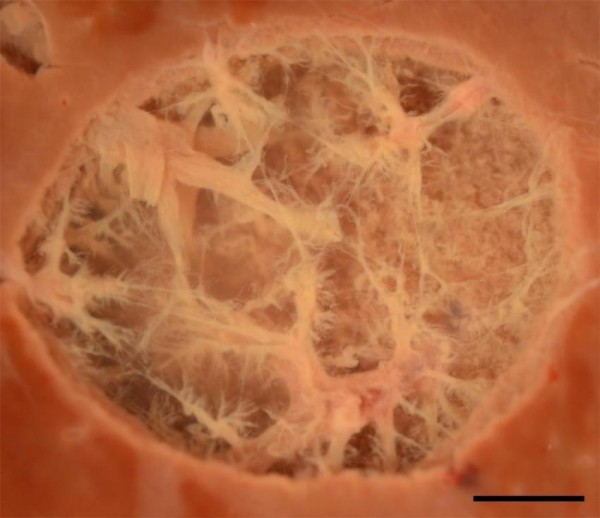High-Intensity Sound Waves May Help Regenerative Medicine
| Marc Maligalig | | Oct 31, 2014 12:01 PM EDT |
(Photo : T. Khoklova/ University of Washington)
Researchers from the University of Washington have developed a way to use sound to create a cellular scaffold for tissue engineering, a novel approach that could help overcome regenerative medicine's prominent hindrances.
The development of a new method started accidentally as the team was initially studying boiling histotripsy, a method that utilizes millisecond-long bursts of high-intensity ultrasound waves to break apart tissue, as a technique to destroy cancerous growths by liquefying them with waves of ultrasound.
Like Us on Facebook
After being destroyed by the sound, the tumors should eliminate the remnants of the cancerous tissues cellular waste. However, when the scientists looked at the "decellularized" tissues, they were shocked with what the process left intact.
"In some of our experiments, we discovered that some of the stromal tissue and vasculature was being left behind," said Yak-Nam Wang, a senior engineer at the University of Washington's Applied Physics Laboratory. "So we had the idea about using this to decellularize tissues for tissue engineering and regenerative medicine."
The structure that remained after the tissues was identified as the extracellular matrix, the fibrous network that acts as a scaffold for the cells to grow upon.
The majority of techniques for decellularizing organs and tissues involve enzymatic and chemical treatments that can cause damage to the fibers and tissues and requires a number of days to finish. On the other hand, the team's histrostipsy method offers the possibility of quick decellularization of tissues with almost none to minimal damage to the cellular scaffolding.
"In tissue engineering, one of the holy grails is to develop biomimetic structures so that you can replace tissues with native tissue," Wang said. "Stripping away cells from already developed tissue could provide a good candidate for these structures, since the extracellular matrix already acts as the cellular framework for tissue systems."
TagsHistotripsy, Ultrasound, Tumor, Cancer, Extracellular matrix, Cells, Regenerative medicine
©2015 Chinatopix All rights reserved. Do not reproduce without permission
EDITOR'S PICKS
-

Did the Trump administration just announce plans for a trade war with ‘hostile’ China and Russia?
-

US Senate passes Taiwan travel bill slammed by China
-

As Yan Sihong’s family grieves, here are other Chinese students who went missing abroad. Some have never been found
-

Beijing blasts Western critics who ‘smear China’ with the term sharp power
-

China Envoy Seeks to Defuse Tensions With U.S. as a Trade War Brews
-

Singapore's Deputy PM Provides Bitcoin Vote of Confidence Amid China's Blanket Bans
-

China warns investors over risks in overseas virtual currency trading
-

Chinese government most trustworthy: survey
-

Kashima Antlers On Course For Back-To-Back Titles
MOST POPULAR
LATEST NEWS
Zhou Yongkang: China's Former Security Chief Sentenced to Life in Prison

China's former Chief of the Ministry of Public Security, Zhou Yongkang, has been given a life sentence after he was found guilty of abusing his office, bribery and deliberately ... Full Article
TRENDING STORY

China Pork Prices Expected to Stabilize As The Supplies Recover

Elephone P9000 Smartphone is now on Sale on Amazon India

There's a Big Chance Cliffhangers Won't Still Be Resolved When Grey's Anatomy Season 13 Returns

Supreme Court Ruled on Samsung vs Apple Dispute for Patent Infringement

Microsoft Surface Pro 5 Rumors and Release Date: What is the Latest?










